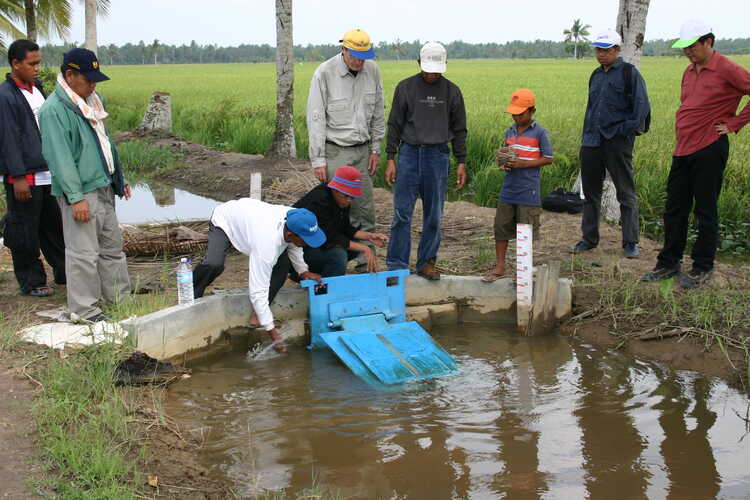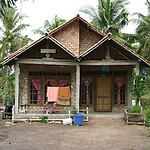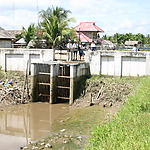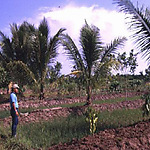Two types of developments took place in these lowland areas in the last decades of the last century: spontaneous transmigration and transmigration projects by the Indonesian government. Spontaneous transmigration had been taking place for years, with the transmigrants usually settling directly on the banks of a river. The Indonesian government's transmigration projects had started around 1970 with a program to settle people from the overpopulated islands of Java, Bali and Madura on the sparsely populated islands of Sumatra, Kalimantan and Papua. The decision was made to develop the reclaimed areas in three phases, namely:
- Phase I: removal of vegetation, construction of an open canal system, and settlement of the new residents. Upon arrival, they received a simple house, a quarter of a hectare for fruit and vegetables, a hectare of cultivated land for rice and a hectare of uncultivated land that they could cultivate themselves over time. In addition, they received food and seeds for the first two years. In this phase, transport mainly took place over water;
- Phase II: installation of water control structures in the canals, which made better water management possible, improvement of agricultural methods and a first step towards roads;
- Phase III: realization of optimal water management with irrigation and drainage, infrastructure development and mechanization in agriculture.
In total, the central government has developed approximately two million hectares in this way, which corresponds to the entire Dutch agricultural area. The idea was that Phases I and II would each last about ten to fifteen years. In practice it took more time. At the end of the last century, most areas were still in Phase I and in a number of areas a start was made with Phase II.
In addition, however, a very interesting development was taking place and that was the rise of the children born in these areas, the first of whom then reached adulthood. This second generation was familiar with the specific local conditions from an early age. Some of them left for the cities in the area, but others developed into good farmers who realised a high production. For example, in the initial phase the rice harvest was at most one ton per hectare. At that time, about six tons of rice per hectare were already harvested in the best areas. These lowland areas had the potential to become the breadbaskets of Indonesia.
The water management systems and land development in these newly developed areas are very rational. As a rule, primary canals were dug between two branches of a river, perpendicular to these canals are the secondary canals and then perpendicular to these canals are the tertiary canals. In Phase I these were open canals, through which the tide - which in some of these areas is a freshwater tide - moved into the tertiary canals. In Phase II, simple movable beam weirs were generally placed in the tertiary canals at the connection with the secondary canals and vertical flap gates that automatically open in the secondary canals at the connection with the primary canals in the event of a difference in water pressure on either side. In itself, this allows excellent water management, but you have to maintain and operate them. This was often lacking and some of the water control structures were broken.
In 1985 I became involved in a certain way in the development of these coastal areas. It was then decided that there would be a joint Indonesian-Dutch symposium to present and discuss developments regarding the government development program from various sides. I was elected the Dutch secretary of the organization, which in retrospect was a fairly grueling position, because three ministries on the Dutch side and five ministries on the Indonesian side were involved in the organization. Therefore, coordination required a lot of patience and creativity. I was fortunate that the Indonesian secretary was excellent, so we usually resolved the problems and issues quickly.
In the lowland areas in the delta of the Musi River in South Sumatra, in which I mainly became involved after the symposium, there is generally a considerable freshwater tide with often a difference of about three meters between high tide and low tide. These areas are generally located just above high tide, which allows good drainage at low tide and water is usually easily available for irrigation at high tide. Moreover, so much rain falls - about 2.5 metres per year - that irrigation is only necessary if crops are grown during the dry season. The water management system therefore needed to function mainly to drain water during the wet season. In the lower areas, agricultural exploitation had to be prevented from regular flooding, which in fact turned them into polders.
In these areas, in the context of a Memorandum of Understanding between the relevant Dutch and Indonesian ministries, we have worked on drawing up guidelines for the operation and maintenance of water management systems and on demonstrating in example areas how harvests could be improved with good water management. Through three seminars, the drafts of the guidelines were discussed with water managers at local, regional and national level and their comments were incorporated. We also demonstrated in a pilot area near Palembang what could be achieved with good water management.
This was well received and subsequently, funds from the Dutch Ministry of Development Cooperation and Indonesia itself were used to improve water management in three demonstration areas with varying conditions. Following this, there has been a long-term collaboration to train Indonesian students as specialists in the field of water management of lowland areas. Contact has always been maintained with the farmers in the demonstration areas. During my last visit in 2014 I was able to see how the areas had developed further. Indeed, it seemed that they will develop into the breadbaskets of Indonesia.




